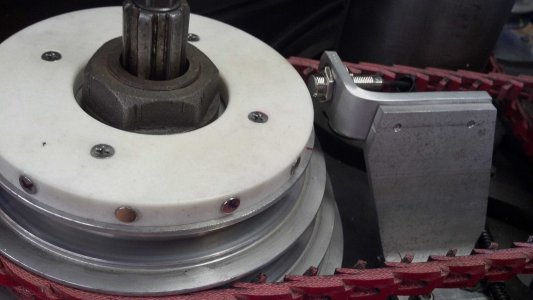- Joined
- Aug 21, 2013
- Messages
- 27
Update and request for help. First I'll update with results of adding more magnets then I have another problem. Keep in mind I purchased the display unit that allowed changing the scale factor to select the number of magnets located on the circumference. I opted to go with 12 magnets and it read good at slow speeds, but as the speed got up to 500+rpm the last couple digits bounced around a lot. I changed out to only 4 magnets and I still read good at low speeds but had a much more stable readout at speeds 500+rpm without the last digit flickering. So I'll probable stay with 4 magnets. By the way, anyone who uses a unit like this with the hall proximity sensors needs to verify the polarity of each magnet before gluing them in place. The sensor will only pick up on one side of the magnet, if you flip it over, the unit won't read it.
Now the problem, the unit reads great up to 950-1050RPM then in that range it stops displaying speed until speed is dropped back down to 950rpm or less. It's not like you have a great deal of flexibility with these types of units so they should be fairly idiot proof, but I have now reached the end of my technical ability. So far I've tried the following things with no change in results;
1. Switched from 12vdc wall wart to my bench power supply to see if maybe unit wasn't getting enough current. Still won't read beyond ~1000rpm.
2. Cut down number of magnets from 12, to 4, then to 2 then to 1. (and YES I changed the prescale factor accordingly as I reduced the number of magnets) Still won't read beyond ~1000rpm.
3. I increased the distance from the magnets to the sensor to the maximum gap that it would still pick up at. Still won't read beyond ~1000rpm.
4. I decreased the distance from the magnets to the sensor to about 1mm. Still won't read beyond ~1000rpm.
5. I have two display units so I swapped them out just in case one was faulty. Still won't read beyond ~1000rpm.
6. I started out using 8mm dia x 3mm thick magnets, but also tried using 25mm dia. Still won't read beyond ~1000rpm.
7. I have an email message in the supplier of the display to see if they have any ideas. Not holding out much hope in this one since they're in China and more than likely just a reseller, plus a lot can get lost in translation. I only gave it a shot because on their page they said 'tell us your requirement, we can custom design for you.' So I was hoping they had someone with technical assistance.
Maybe someone with more technical expertise can think of something I'm missing.
Now the problem, the unit reads great up to 950-1050RPM then in that range it stops displaying speed until speed is dropped back down to 950rpm or less. It's not like you have a great deal of flexibility with these types of units so they should be fairly idiot proof, but I have now reached the end of my technical ability. So far I've tried the following things with no change in results;
1. Switched from 12vdc wall wart to my bench power supply to see if maybe unit wasn't getting enough current. Still won't read beyond ~1000rpm.
2. Cut down number of magnets from 12, to 4, then to 2 then to 1. (and YES I changed the prescale factor accordingly as I reduced the number of magnets) Still won't read beyond ~1000rpm.
3. I increased the distance from the magnets to the sensor to the maximum gap that it would still pick up at. Still won't read beyond ~1000rpm.
4. I decreased the distance from the magnets to the sensor to about 1mm. Still won't read beyond ~1000rpm.
5. I have two display units so I swapped them out just in case one was faulty. Still won't read beyond ~1000rpm.
6. I started out using 8mm dia x 3mm thick magnets, but also tried using 25mm dia. Still won't read beyond ~1000rpm.
7. I have an email message in the supplier of the display to see if they have any ideas. Not holding out much hope in this one since they're in China and more than likely just a reseller, plus a lot can get lost in translation. I only gave it a shot because on their page they said 'tell us your requirement, we can custom design for you.' So I was hoping they had someone with technical assistance.
Maybe someone with more technical expertise can think of something I'm missing.


